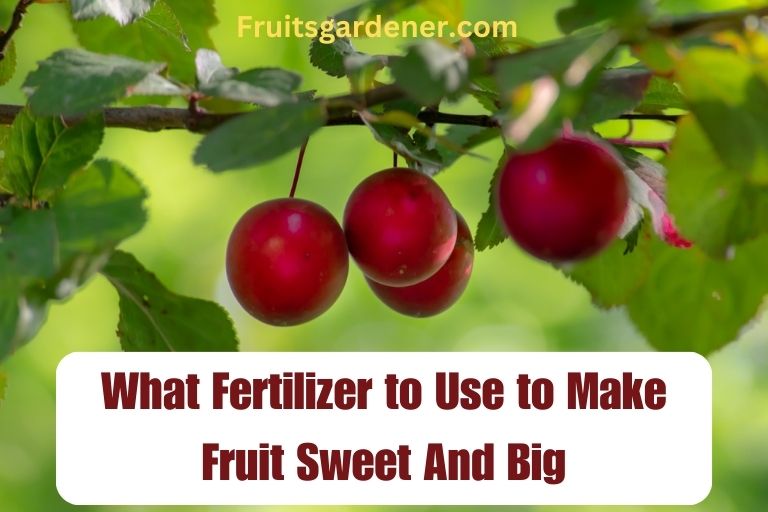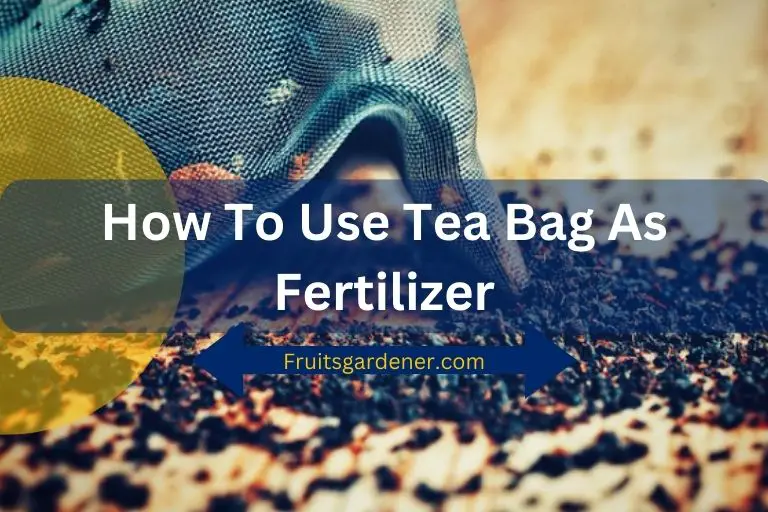Fruit trees are a wonderful addition to any home. Not only do they provide fresh fruit for you and your family to enjoy, but they also add beauty and value to your property. While store-bought fertilizer can be expensive, there are many ways to make your own homemade fertilizer for fruit trees.
One of the best ways to fertilize fruit trees is by using compost. Compost is rich in nutrients that will help promote healthy growth in your trees. You can either purchase compost from a local nursery or make your own at home.
If you choose to make your own compost, be sure to include a variety of organic materials such as leaves, grass clippings, and kitchen scraps. Another great way to fertilize fruit trees is by using manure. Manure is an excellent source of nutrients and can be easily found at most garden centers or farm supply stores.
Be sure to age the manure before using it on your fruit trees – this will help minimize the risk of burning the roots of your plants.
One of the best ways to ensure a healthy and bountiful fruit harvest is to start with healthy, well-nourished trees. And one way to do that is to feed them regularly with homemade fertilizer tailored specifically for fruit trees.
3 Recipes for Homemade Fertilizer for Fruit Trees That You Can Whip Up in Your Kitchen
1. Banana Peel Fertilizer:
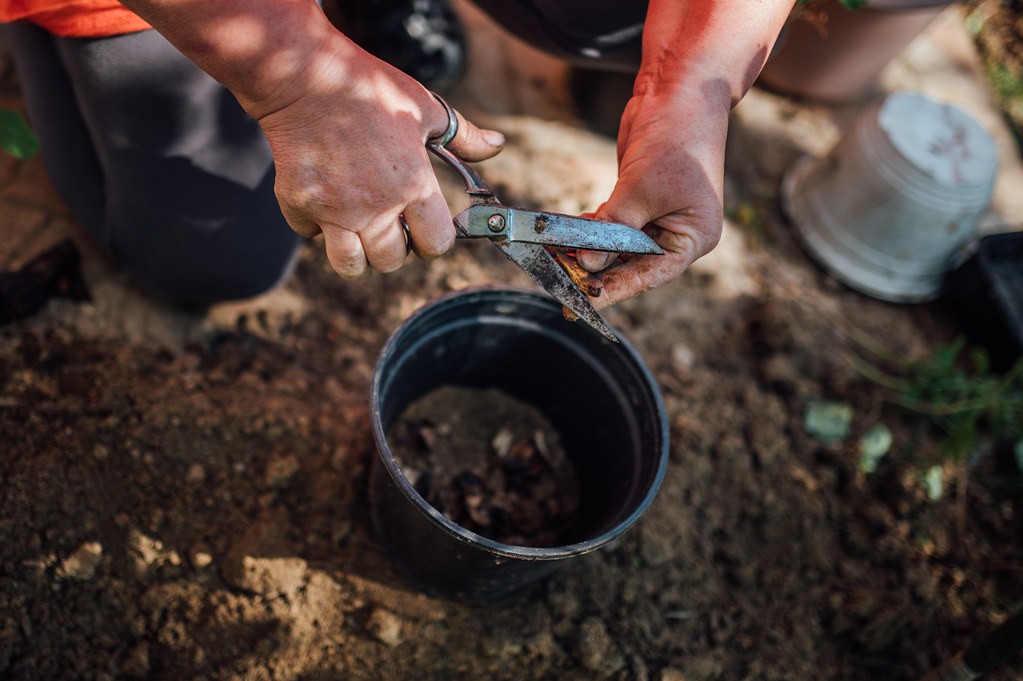
Banana peels are rich in potassium, which is essential for strong and vigorous tree growth. Simply chop up some banana peels and bury them around the base of your trees. As they decompose, they’ll release their nutrients into the soil, giving your trees a boost.
Process of Making Fertilizer Using Banana Peels –
Banana peels can be a great source of nutrients for fruit trees when used as fertilizer. Here’s a simple method to make fertilizer using banana peels:
Collect banana peels: Start by collecting banana peels from ripe bananas. You can use peels from multiple bananas to have a sufficient amount for fertilizing your fruit trees.
Cut the peels: Cut the banana peels into small pieces. This will help speed up the decomposition process.
Prepare a compost pile or hole: Choose a suitable spot in your garden or create a compost pile/bin. If you prefer to directly fertilize a specific fruit tree, dig a small hole near the tree.
Add the peels: Place the banana peel pieces in the compost pile or directly into the hole near the fruit tree. Make sure to cover them with a layer of soil or compost.
Incorporate other organic matter (optional): To enhance the nutritional content of your fertilizer, you can add other organic matter like vegetable scraps, coffee grounds, or grass clippings. This will contribute to the overall nutrient profile of the fertilizer.
Water and monitor: Water the compost pile or the area around the fruit tree to ensure the decomposition process begins. Monitor the moisture levels and keep the compost pile moist, but not overly wet. This will help break down the banana peels faster.
Turn the compost (optional): If you have a compost pile, turning it periodically will help accelerate decomposition. This step is optional but can speed up the process of converting the peels into usable fertilizer.
Wait and use the fertilizer: Depending on the environmental conditions and the size of the banana peel pieces, the decomposition process may take several weeks to a few months. Once the peels have broken down and turned into dark, crumbly material, the fertilizer is ready to be used.
Apply the fertilizer: Spread the composted banana peel fertilizer around the base of your fruit tree. You can gently work it into the soil or leave it on the surface as a mulch. Avoid placing the fertilizer directly against the tree trunk.
By following these steps, you can create a nutrient-rich fertilizer using banana peels that will benefit the growth and development of your fruit trees.
2. Eggshell Fertilizer:
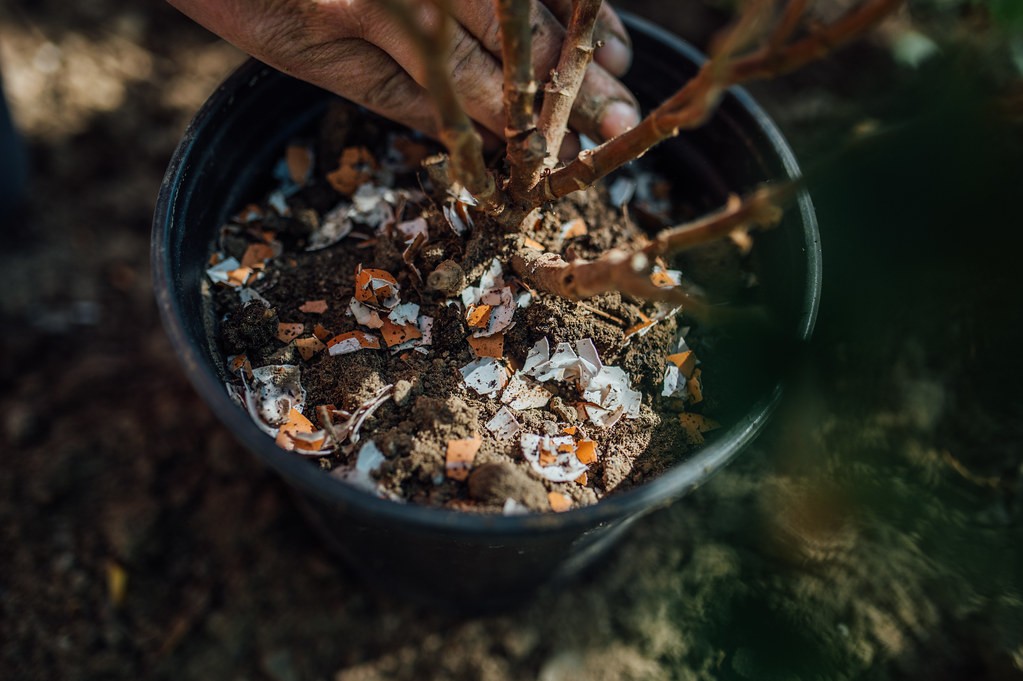
Eggshells are an excellent source of calcium, which is necessary for proper cell development in plants. To use them as fertilizer, just crush up some eggshells and sprinkle them around the base of your trees. They’ll slowly release their nutrients as they decompose.
Process of Making Fertilizer Using Eggshell –
Eggshells can be a valuable source of calcium and other minerals for fruit trees. Here’s a simple method to make fertilizer using eggshells:
Collect eggshells: Start by collecting eggshells from your kitchen. Rinse them with water to remove any remaining egg white or yolk.
Dry the eggshells: Allow the eggshells to dry thoroughly. You can spread them out on a windowsill or baking sheet and let them air dry for a few days. Alternatively, you can bake them in the oven at a low temperature (around 200°F or 95°C) for about 20 minutes to expedite the drying process.
Crush the eggshells: Once the eggshells are dry and brittle, crush them into small pieces or grind them into a fine powder using a mortar and pestle, blender, or food processor. The finer the particles, the quicker they will break down and release nutrients.
Incorporate the eggshells into the soil: Dig a small hole or trench around the base of your fruit tree. Sprinkle the crushed eggshells evenly into the hole or trench. Alternatively, you can mix the crushed eggshells with compost or soil before applying them.
Cover and water: Once the eggshells are applied, cover them with a layer of soil or compost and water the area thoroughly. This will help start the breakdown process and allow the nutrients to be absorbed by the tree’s roots.
Repeat the application: You can repeat this process periodically throughout the growing season to provide a steady supply of calcium and minerals to the fruit tree. Every 4-6 weeks is a good interval for applying eggshell fertilizer.
It’s important to note that eggshells primarily provide calcium and other trace minerals, so they should be used in conjunction with other organic fertilizers to provide a balanced nutrient profile for your fruit tree.
Additionally, the eggshells will break down slowly, so it may take some time for the nutrients to become available to the tree. Patience is key when using eggshell fertilizer.
By following these steps, you can effectively make and use fertilizer from eggshells to benefit the growth and health of your fruit trees.
3. Coffee Ground Fertilizer:
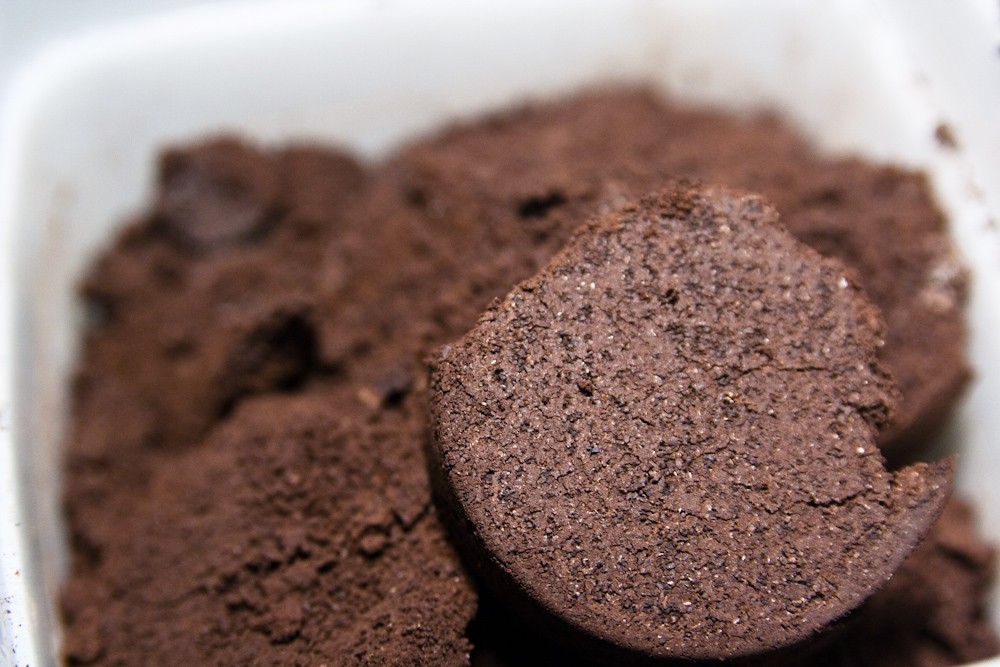
Coffee grounds are rich in nitrogen, phosphorus, and potassium – all vital nutrients for healthy plant growth. You can either mix coffee grounds into the soil around your trees or make a compost tea by steeping them in water and then watering your trees with it. Either way, they’ll love it.
Process of Making Fertilizer Using –
Coffee grounds can be a beneficial source of nitrogen and organic matter for fruit trees. Here’s a simple method to make fertilizer using coffee grounds:
Collect coffee grounds: Start by collecting used coffee grounds from your coffee maker or local coffee shop. You can also ask your friends or neighbors to save their coffee grounds for you.
Dry the coffee grounds (optional): Coffee grounds are typically wet after brewing. If you prefer to use dry coffee grounds, spread them out on a baking sheet or tray and allow them to air dry for a few days. Alternatively, you can mix them directly into the soil while they are still moist.
Prepare the soil: Dig a small trench or hole around the base of your fruit tree, or choose a location where you want to apply the coffee grounds. Loosen the soil to ensure good contact between the coffee grounds and the roots of the tree.
Apply the coffee grounds: Spread a layer of coffee grounds around the base of the fruit tree. You can sprinkle them directly onto the soil or mix them into the top layer. It’s best to spread the coffee grounds in a thin layer to avoid compacting the soil.
Water the area: After applying the coffee grounds, water the area thoroughly. This helps the coffee grounds integrate with the soil and release their nutrients gradually.
Repeat the application: Coffee grounds can be applied periodically throughout the growing season. Every few weeks or once a month is a suitable frequency. Avoid applying excessive amounts of coffee grounds at once, as it can affect the soil pH.
Monitor the soil pH: Coffee grounds are slightly acidic, so if you are using them in large quantities, it’s important to monitor the soil pH. Fruit trees generally prefer slightly acidic to neutral soil. If you notice a significant drop in pH, you can balance it by adding agricultural lime or other amendments to raise the pH if necessary.
Coffee grounds provide nitrogen, potassium, and some trace minerals to the soil, benefiting the growth and development of fruit trees. However, it’s important to use coffee grounds in moderation and in conjunction with other organic fertilizers to maintain a balanced nutrient profile.
By following these steps, you can make and use fertilizer from coffee grounds to enhance the health and productivity of your fruit trees.
Is Epsom Salt Good for Fruit Trees?
The short answer is yes, Epsom salt is good for fruit trees. Here’s a deeper look at why and how to use it. Epsom salt is made up of magnesium sulfate, which is essential for plant growth.
Magnesium helps with photosynthesis, strengthens cell walls, and promotes chlorophyll production – all of which are important for healthy plants. Sulfur is another important element in Epsom salt. It aids in seed germination, root development, and overall plant health.
Sulfur also helps reduce the incidence of certain diseases in plants. To use Epsom salt on your fruit trees, mix 1 tablespoon per gallon of water and apply it around the base of the tree once per month. You can also add Epsom salt to your compost pile to help increase its nutrient content.
Homemade Liquid Fertilizer for Fruit Trees
When it comes to fruit trees, homemade liquid fertilizer is one of the best ways to ensure a healthy crop. Not only is it less expensive than store-bought options, but you can also tailor it to your tree’s specific needs. Here’s everything you need to know about making your own liquid fertilizer for fruit trees.
The first step is to gather your ingredients. For this recipe, you’ll need 1 cup of water, 1/2 cup of molasses or honey 1/4 cup of apple cider vinegar.
What Fertilizer Make Fruit Bigger?
There are a few different types of fertilizer that can be used to make fruit bigger. One type is called compost, which is made from decomposed organic matter such as leaves and grass clippings. This type of fertilizer helps improve the soil quality and drainage, which in turn can lead to larger fruits.
Another type of fertilizer that can be used is manure, which is rich in nutrients that help promote plant growth. Manure can also help improve soil quality, but it is important to use organic manure that has not been treated with chemicals. Finally, chemical fertilizers can also be used to make fruit bigger.
These fertilizers typically contain high levels of nitrogen, phosphorus, and potassium, which are essential nutrients for plant growth. However, it is important to use these products sparingly and according to the manufacturer’s instructions, as too much fertilizer can actually damage plants.
What Fertilizer to Use to Make Fruit Sweet
If you want to make your fruit sweeter, you need to use the right fertilizer. There are a few different types of fertilizer that can be used, but not all of them will work well for this purpose. Here is a look at some of the best options for making your fruit sweeter:
1. Potassium Nitrate: Potassium nitrate is a type of fertilizer that is known for its ability to make fruits sweeter. It works by increasing the level of sugar in the fruit, which makes it taste sweeter. This fertilizer is also good for promoting growth and improving the overall health of plants.
2. Epsom Salt: Epsom salt is another option that can be used to make fruits sweeter. It works similarly to potassium nitrate, by increasing the level of sugar in the fruit. This fertilizer is also good for promoting plant growth and improving overall plant health.
3. Sugar Beet Pulp: Sugar beet pulp is another effective option for making fruits sweeter. It works by providing additional sweetness to the fruit, making it taste even better.

Credit: couchtohomestead.com
Homemade Fertilizer for Papaya Tree
Papaya trees are native to tropical regions and require warm temperatures to grow. They are fast-growing trees that can reach up to 20 feet in height. Papayas are typically started from seed, although they can also be propagated by rooting stem cuttings.
Once established, papaya trees are relatively easy to care for and do not require much fertilizer. Homemade fertilizer for papaya trees is a great way to provide your tree with the nutrients it needs without having to spend a lot of money on commercial products. There are a few different recipes you can use depending on what ingredients you have available.
One simple recipe is to mix together equal parts of manure and compost. This mixture should be applied around the base of the tree once every two weeks during the growing season. Another option is to combine one part blood meal with two parts bone meal and three parts wood ashes.
This fertilizer should be applied once a month during the growing season. Whichever recipe you choose, make sure you apply the fertilizer evenly around the base of the tree and water it well afterward. With proper care and feeding, your papaya tree will produce an abundance of delicious fruit for many years to come!
Homemade Fertilizer for Fig Tree
Figs are one of the oldest fruits known to man, and they have been cultivated since ancient times. The fig tree is native to Asia, Africa, and the Mediterranean region. Fig trees grow in a wide range of climates, from tropical to temperate.
Fig trees are relatively easy to grow, and they do not require a lot of fertilizer. However, if you want to produce large, juicy fruit, then you will need to fertilize your tree regularly. There are many different recipes for homemade fertilizer for fig trees.
You can use any combination of organic materials that you have on hand. Here is one simple recipe that you can use: Ingredients: 1 part blood meal, 1 part bone meal, 1 part kelp meal, or composted seaweed.
What is the Best Natural Fertilizer for Fruit Trees?
When it comes to fertilizing fruit trees, there are a few different options available. However, not all of them are created equal. In order to get the best results, you need to choose the right fertilizer for your particular tree.
One of the best natural fertilizers for fruit trees is compost. This is because it contains a variety of nutrients that trees need in order to grow and produce healthy fruit. It also helps improve drainage and aeration in the soil, which can be beneficial for roots.
Another option is using manure from herbivores such as cows or rabbits. This manure is high in nitrogen, which is an essential nutrient for plants. It can also help improve soil structure and encourage microbial activity.
Finally, another good natural fertilizer for fruit trees is bone meal. This provides phosphorus and other minerals that are beneficial for plant growth. It can also help add organic matter to the soil, which can improve its fertility over time.
How Do You Make Natural Fertilizer for Trees?
You can make natural fertilizer for trees by using leaves, grass clippings, and other organic matter. To do this, you need to create a compost pile. This is done by layering the organic matter in a 3:1 ratio of carbon to nitrogen.
Once you have your compost pile created, you will need to water it regularly and turn it in every few weeks. After about two months, your compost should be ready to use as fertilizer for your trees.
How Can I Make Natural Fertilizer at Home?
Another way is to use mulch from leaves, grass, or other organic materials. This will add nutrients to the soil as it decomposes. You can also use manure from animals such as chickens, rabbits, or horses.
Manure contains high levels of nitrogen, phosphorus, and potassium which are essential for plant growth. If you want to make a more concentrated fertilizer, you can make an herbal tea infusion using comfrey, nettles, or yarrow. These herbs contain high levels of minerals and trace elements that plants need for healthy growth.
To make an herbal tea infusion, simply steep 1-2 ounces of dried herb in a quart of boiling water for 30 minutes. Once it has cooled, you can apply it directly to the soil around your plants or dilute it with water and use it as a foliar spray.
How Do You Treat Fruit Trees Organically?
Some varieties of fruit trees are more tolerant of cold or heat than others. You’ll also want to make sure that the tree you select is disease-resistant. Next, prepare your soil before planting by adding organic matter such as compost or manure.
This will help improve drainage and provide nutrients for your tree. When planting, be sure to dig a hole that is twice as wide as the root ball and just deep enough so that the roots can be covered with soil. Gently remove any damaged roots and backfill the hole with loose soil, tamping it down lightly around the base of the tree.
Water well after planting. Once your tree is established, water it deeply once a week during dry periods. Apply a layer of mulch around the base of the tree to help conserve moisture and prevent weed growth. Fertilize annually with an all-purpose organic fertilizer or compost tea.
How to Make Homemade Fertilizer for Flowers and Fruit Plants
Conclusion
Fruit trees are a great addition to any home landscape and can provide an abundance of fresh fruit for your family. While store-bought fertilizers can be expensive, there are many ways to make your own homemade fertilizer for fruit trees. Compost is a great way to add nutrients back into the soil and can be made from kitchen scraps and yard waste.
Another easy way to fertilize fruit trees is by using green manure, which is simply adding fresh grass clippings or other green plants around the base of the tree. You can also use coffee grounds or eggshells as natural fertilizers for your fruit trees. Simply spread them around the base of the tree and water the well.
By using some simple ingredients, you can easily make your own homemade fertilizer for fruit trees and save money in the process.

